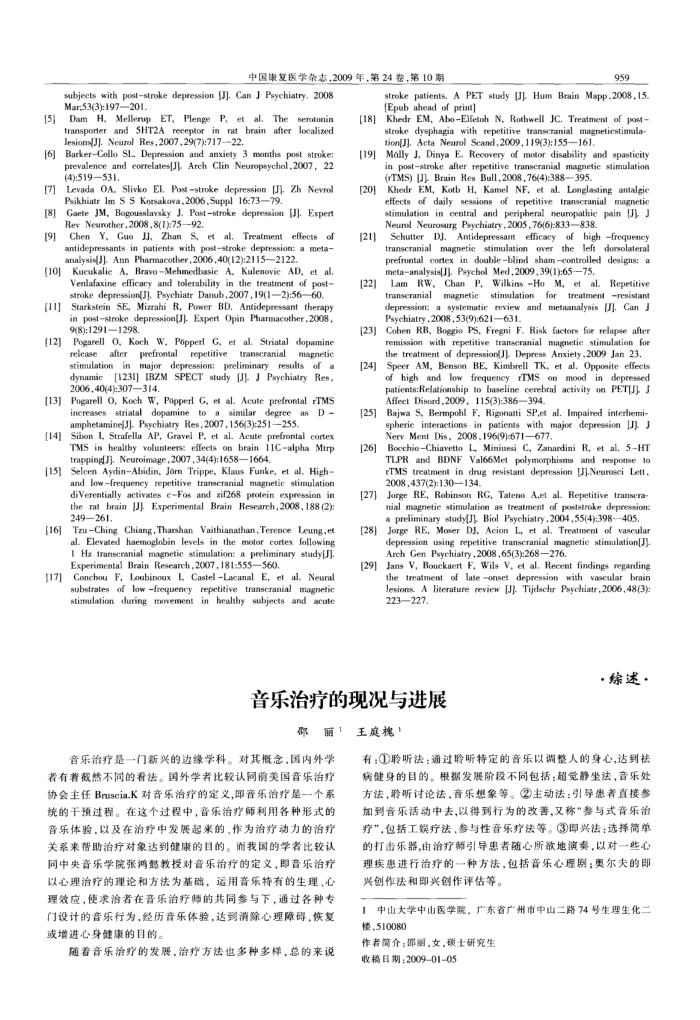您当前的位置:首页>论文资料>音乐治疗的现况与进展
内容简介
 [5][6][7][8][6]
[5][6][7][8][6]中国康复医学杂志,2009年,第24卷,第10期
subjects with poststroke depression [J]. Can J Psychiatry. 2008 Mar,53(3):197201.
The
Dam H,Mellerup
ET,Plenge
et
al.
Serotonin
transporter and 5HT2A receptor in rat brain
after localized
lesions[J]. Neurol Res,2007,29(7):71722.
BarkerCollo SL. Depression and anxiety 3 months post stroke: prevalenee and eorrelates[J] Arch Clin Neuropsychol,2007, 22(4):519531.
Levada OA, Slivko EI. Post=stroke depression [J]. Zh
Nevrol
Psikhiatr Im S S Korsakova,2006,Suppl 16:73—79.
Gaete JM, Bogousslavsky J. Poststroke depression [] Rev Neurother,2008,8(1):75—92.
Expert
Chen Y, Cuo J, Zhan S, et al. Treatment
effects of
antidepressants in patients with poststroke depression: a meta
analysis(J]. Ann Pharmaeother,2006,40(12):2115—2122.
Kucukalie A, BravoMehmedbasic A, Kulenovic AD, et al.[10]
Venlafaxine efficacy and tolerability in the treatment of post stroke depression[J]. Psychiatr Danub,2007, 19(1—2):56—60.
[1]][12]
[E][14][15]
[16]
Starkstein SE, Mizrahi R, Power BD. Antidepressant therapy in poststroke depression[J] Expert Opin Pharmacother,2008, 9(8):1291—1298.
Pogarell O, Koch W, Papperl G, et al. Striatal
dopamine
transcranial
reiease
prefrontal
repetitive
magnetie
after
major depression: preliminary
stimulationin
resultsofa
dynamie [123] IBZM SPECT study [J]. J Psychiatry Res, 2006,40(4):307314.
Pogarell O, Koch W, Papperl G, et al. Acute prefrontal rTMS increases striatal dopamine
similar degree as
D-
toa
amphetamine[J., Psychiatry Res,2007,156(3):251255.
Sibon 1, Strafella AP, Gravel P, et al. Acute prefrontal cortex TMS in heaithy volunteers:_ effeets on brain_ i1Calpha Mtrp trappingJJ. Neuroimage,2007,34(4):1658—1664.
Selcen AydinAbidin, Jom Trippe, Klaus Funke, et al. High and lowfrequeney repetitive transeranial magnetic stimulation diVerentially activates e-Fos and_ zif268_ protein expression in the rat brain [J]. Experimental Brain Research,2008,188 (2): 249261.
Chiang,Tharshan Vaithianathan,Terence Leung,et
al. Elevated haemoglobin levels in the motor cortex following 1 Hz transcranial magnetic stimulation: a preliminary study(J] Experimental Brain Research,2007,181:555—560.
Conchou F, Loubinoux I, Castel Lacanal E, et al. Neural[17]
of low frequency repetitive transcranial magnetic
substrates
stimulation during movement
in healthy subjects
andacute
[18][19][z]
[21][22][23][24]
[25][26]
[27][28][29]
959
stroke patients, A PET study [J]. Hum Brain Mapp.2008,15[Epub ahead of print]
Khedr EM, AboEIfetoh N, Rothwell JC. Treatment of post stroke dysphagia with repetitive transcranial magneticstimula-tion[J]. Acta Neurol Scand,2009,119(3):155—16].
Mally J, Dinya E. Recovery of motor disability and spasticity in poststroke after repetitive transcranial magnetic stimulation(rTMS) [J), Brain Res Bull,2008,76(4):388395.
Khedr EM, Kotb H, Kamel NF. et al. Longlasting antalgic effects of daily sessions_ of repetitive transcranial magnetic stimulation in central and peripheral neuropathic F
pain[J]J
Neurol Neurosurg Psychiatry , 2005, 76(6):833838.
Schutter DJ. Antidepressant efficacyof high frequency transcranial magnetic stimulation over the left dorsolateral prefrontal cortex in doubleblind_shameontrolled designs: a
metaanalysis[J]. Psychol Med,2009 ,39(1):65—75. Lam RW, Chan P,
Wilkins HoM,etal.
Repetitive
fortreatment resistant
stimulation
transcranial
magnetic
depression: a systematic review and metaanalysis []. Can J Psyehiatry ,2008,53(9):621—631.
Cohen RB, Boggio PS, Fregni F. Risk factors for relapse after remission with repetitive transcranial magnetic stimulation for the treatment of depression[J], Depress Anxiety ,2009 Jan 23. Speer AM, Benson BE, Kimbrell TK, et al. Opposite effects of high and low frequency rTMS on mood in depressed patients:Relationship to baseline cerebrai activity on PET[J, J Affect Disord,2009, 115(3):386—394.
Bajwa S, Bermpohl F, Rigonati SP,et al. Impaired interhemi-spherie interactions in patients with major depression [J] J Nerv Ment Dis, 2008,196(9):671—677.
BocchioChiavetto L, Miniussi C, Zanardini R, et al. 5HT
Val66Met polymorphisms and response to
TLPR and BDNF
rTMS treatment in drug resistant depression [J].Neuresci Lett, 2008,437(2):130134,
Jorge RE, Robinson RG, Tateno A,et al. Repetitive transcra-nial magnetie stimulation as treatment of poststroke depression: a preliminary study[J], Biol Psychiatry,2004,55(4):398—405. Jorge RE, Moser DJ, Acion L, et al. Treatment of vascular depression using repetitive transeranial magnetic stimulation[J] Arch Gen Psychiatry ,2008,65(3):268—276.
Jans V, Bouckaert F, Wils v, et al. Reent findings regarding the treatment of late onset depression with vascular brain lesions. _ A literature review [J]. Tijdschr Psychiatr,2006,48(3): 223—227.
音乐治疗的现况与进展
鄂
丽1
音乐治疗是一门新兴的边缘学科。对其概念,国内外学者有着截然不同的看法。国外学者比较认同前美国音乐治疗协会主任Bruscia.K对音乐治疗的定义,邸音乐治疗是一个系统的干预过程。在这个过程中,音乐治疗师利用各种形式的音乐体验,以及在治疗中发展起来的、作为治疗动力的治疗关系来帮助治疗对象达到健康的目的。而我国的学者比较认同中央音乐学院张鸿懿教授对音乐治疗的定义,即音乐治疗以心理治疗的理论和方法为基础,运用音乐特有的生理、心理效应,使求治者在音乐治疗师的共同参与下,通过各种专门设计的音乐行为,经历音乐体验,达到消除心理障碍,恢复或增进心身健康的目的。
随着音乐治疗的发展,治疗方法也多种多样,总的来说
王庭槐!
·综述
有:①聆听法:通过聆听特定的音乐以调整人的身心,达到祛病健身的目的。根据发展阶段不同包括:超觉静坐法,音乐处方法,听讨论法,音乐想象等。(
②主动法:引导惠者直接参
加到音乐活动中去,以得到行为的改善,又称"参与式音乐治疗”,包括工娱疗法,参与性音乐疗法等。③即兴法:选择简单的打击乐器,由治疗师引导患者随心所欲地演奏,以对一些心理疾患进行治疗的一种方法,包括音乐心理剧;奥尔夫的即兴创作法和即兴创作评估等。
中山大学中山医学院,广东省广州市中山二路74号生理生化二楼,510080
作者简介:邵丽,女,硕士研究生收稿日期:20090105
上一章:血小板增多与非小细胞肺癌关系的研究进展
下一章:胰岛素样生长因子系统与乳腺癌